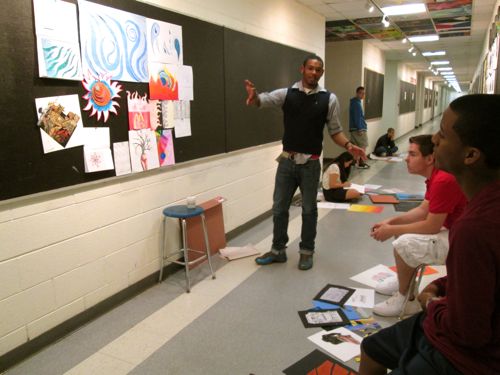While I have used portfolios with students since my first year teaching, the way I use portfolios has changed. Teachers (and not just art teachers) know that they can be a valuable assessment tool, an engaging way for students to reflect on their work, and obviously a way to stay organized for everyone involved. But this spring I began using portfolios in a different way after looking back on the approaches I had taken in the past.
Instead of simply using the portfolio as a way for students to reflect on their work and self-evaluate their progress, this year we went looking for the things we didn’t notice as we were working on separate projects.
A few weeks before the end of the school year, right before the classic “final project” assignment that rolls around at the conclusion of a course, I asked my students to take their portfolios into the hallway and literally spread out everything that was inside. There were sketches for ideas that never materialized, finished works of art, sketchbooks, notes, visual references and more. I asked my classes, “What do you see?”, and really pressed them hard to tell me about the things they noticed when they looked at all of their work together as a whole. One student said she hadn’t noticed so many of her works incorporated the color red. Another noticed that she had developed an interest in experimenting with photography. A third student saw many works that involved some kind of movement and trying to picture objects in motion.
After making some notes on what they saw and the things that rose to the surface when these works were seen at the same time, I asked students to think about how the experience with their portfolios could influence a new piece to wrap up the year (technically their final “exam” for me). Students were challenged to think about how the themes, colors, ideas and subject matter featured in their portfolio could inspire something totally new. And instead of relying on the materials we used over the past year I encouraged them to also experiment with their choice of media.
Some of the work that stood out included a layered collage after Darique (pictured above) discovered certain kinds of shapes continuously came up in his work and that he loved “drawing with a blade”. Another student decided to use her Mom’s Poloroid cameras in order to make a large work from many small pieces she shot herself. A third took the opportunity to create a fluid, delicate watercolor and then subsequently discovered the work of Polly Apfelbaum after we got to investigating her approach to the composition and working with particular shapes.
Similar to in-progress critiques, portfolio reflections and evaluations do not have to arrive at the end of things. Utilized during the course, it allows for both looking backward and looking forward.
